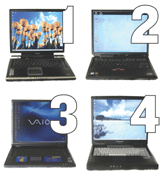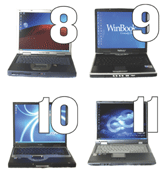Replacing your desktop PC with a high-end notebook system no longer means a step down in performance'as long as you choose the right notebook PC with the right chip.Of the 11 notebooks we tested for this review, those with the new Intel Pentium Centrino performed best.Centrino combines an 855 chipset with embedded Intel Pro/Wireless 2100 networking. Without the embedded wireless capability, Centrino is a Pentium M.The power of the Pentium M chip comes from the upgraded chipset's 1M of Level 2 cache as opposed to the older 512K L2 die. Plus, the 855 chipset supports up to 2G of 200-MHz or 266-MHz double-data-rate RAM. Older chipsets peaked at 1G.But most important, the Pentium M uses only a fraction of the power that's needed to run a Mobile Pentium 4. The Pentium M draws 0.5 watt; the Mobile Pentium 4 takes 1.5 watts.This energy advance means that Centrino and Pentium M notebooks are quieter, generate less heat and have longer battery life than notebooks with other chips. Some Centrino notebooks last up to six hours on a single charge.Other bonuses are faster boot time and processing. Despite the marvels of this latest Intel chip, it's important to look at the sum of all the parts before permanently giving up a desktop PC for a notebook.[IMGCAP(2)] To identify ideal desktop PC replacements, we rated high-end notebooks from 11 companies. Our grading took into account the amount of RAM, bus transfer rate, heat displacement, chassis design, video memory and price, along with special features such as wireless capability and Gigabit Ethernet cards. The price-to-performance ratio also figured prominently.Because we had to compare three different processors, we calibrated the GCN Lab's Alterion Corp. benchmarks to focus on CPU performance as it relates to the rest of the PC. The series of tests incorporated Microsoft Excel and PKZip from PKWare Inc. of Brown Deer, Wis.To examine each notebook as a whole, we calibrated the Alterion benchmarks to rate graphical performance with Adobe Photoshop 6.We compared the benchmark scores against the results from our baseline computer, a 1.5-GHz Pentium 4 client with 256M of RAM from eMachines Inc. of Irvine, Calif. It scored 15,796 on the processor-specific test and 19,918 overall.The Toshiba Tecra S1 topped 10 competitors on the benchmark tests. As a desktop replacement, you won't find a better-performing system. It turned in a scorching 33,765 on the overall benchmark, 138 percent faster than the lab's baseline system.But the Tecra wasn't all about CPU speed. It had a lot of nice extras and wasn't too hefty for portability.It was the only reviewed system that came with a full version of the Centrino, including integrated wireless capability. The Tecra was faster than notebooks featuring full Pentium 4 desktop chips and not even down in the same ball park with those running Mobile Pentium 4 chips.Even before benchmarking, we saw hints that the Tecra S1 was fast. It opened Photoshop so quickly that we almost forgot it wasn't a desktop computer.It had three Universal Serial Bus 2.0 ports and one video-out port for streaming a presentation to a larger screen. It also came loaded with a DVD/CD-rewritable combination drive. Its ATI Mobility Radeon 9000 graphics controller outperformed other controllers in the review.The Tecra was surprisingly light, though at 6.1 pounds, not exactly featherweight. There's no reason not to carry a notebook'with everything you need at your fingertips'just because it's three pounds heavier than an ultraportable. A notebook that weighed in at 9 pounds would be excessive, but 6 pounds is totable.The Tecra cost more than most of the other notebooks, but the extra performance made it worthwhile, especially as a desktop replacement machine. We gave it an A+ and a Reviewer's Choice designation because it clearly was the most impressive of the 11 systems reviewed.The IBM ThinkPad R40 was one of the few Mobile Pentium notebooks that performed well.At 23,596 on the processor benchmark, it scored a bit below the Tecra but in the same neighborhood. The interesting thing about the R40 was its price'at $1,919, the least expensive of the systems reviewed and comparable to the top performer for roughly $1,000 less than most of its rivals.And the R40 was no slouch. Although it lacked the Centrino's embedded wireless capability, it did have an R40 UltraConnect antenna running up both sides of the display. The result: excellent signal strength no matter what its position in relation to an access point.We gave the R40 an A and the Bang for the Buck designation for its respectable performance, good features and amazing price.The Sony Vaio GRX770 was a heavyweight at 8.6 pounds and more along the lines of what we've come to expect of a desktop replacement.Despite a 2.2-GHz Mobile Pentium processor, the GRX770 turned in a good performance and scored 23,655 on the processor test, slightly faster than the ThinkPad.It had three USB ports, all protected by flip-down plastic doors. Each USB port was on a different side, so getting to one was easy from any angle. The notebook also had a 16-inch SXGA display'the most impressive in the review.[IMGCAP(3)] Some of the GRX770's extras seemed geared for consumers, such as movie-editing software, but there are business uses for such applications, too. Like the Tecra, the Vaio had a DVD/CD-RW combo drive'a nice input-output device that took up only one drive bay.Though hefty, the GRX770 crunched apps like a desktop PC. It also had a reasonable price. We gave it an A- for above-average performance and specifications, and the only other Reviewer's Choice designation.The Panasonic Toughbook CF-50 was a solid performer that scored well if not stunningly.Panasonic more often submits its rugged systems to the lab for review than its desktop replacements. The CF-50 was part of the Toughbook lineup, though there was nothing particularly rugged about it. But its 2.2-GHz Mobile Pentium 4 performed in line with other top systems, scoring 23,245 on the processor benchmark.And at 7.7 pounds, it was lighter than the Sony though somewhat thicker. The explanation was lots of empty space inside. The CF-50, in fact, felt a bit hollow when lifted.The extras included a pair of integrated stereo speakers that, while good, could not top the amazing quality of the speakers in the Hewlett-Packard Evo N800.The CF-50 couldn't grab the top spot in any of the tests, though its scores across the board were above average. It would be a good choice for users who aren't 100 percent sure how they will use it but want a solid performer.The Acer TravelMate 800 was built on a Pentium M'a Centrino without integrated wireless. It scored high on the processor benchmark, getting 26,004. Extras included a large, 60G hard drive and four USB 2.0 ports. The TravelMate 800, like the Tecra, came with the snazzy ATI Mobility Radeon 9000 graphics chip.Unfortunately, it had only a single DVD-ROM drive, whereas every other notebook reviewed had either a writable DVD or a DVD/CD-RW combo drive. To replace a desktop PC, a notebook really should have a writable media option.On the plus side, at 5.7 pounds, the TravelMate was quite portable and would make a good choice for users counting ounces.The Gateway 600XL was a good system that kept its cool. Its 2.5-GHz Mobile Pentium 4 scored 23,100 on the processor benchmark without generating excessive heat.The 600XL sported the high-end ATI Mobility Radeon 9000 graphics chip. A 15.7-inch SXGA display showed images crisply and clearly. The speakers sounded extremely good, though not quite as good as those of the Dell Latitude D800 and nowhere near the HP Evo's.The $2,400 price tag made the 600XL an affordable option, but you could get the Tecra's speedier chip and other goodies for about $500 more.We gave the 600XL a B. It would be a good choice if you don't mind a bit of a speed reduction in exchange for a few hundred dollars of savings.The Dell Latitude D800 was the slowest performer of the Mobile Pentium and Centrino notebooks. Although it got the second-highest score on the full benchmark at 32,387, its processor score was 23,041. That was above average, but the 1.6-GHz Pentium M notebook fell short of the others reviewed.Its biggest drawback was price'$2,734. That covered extras such as an integrated smart-card reader, a DVD-ROM/CD-RW combo drive, 512M of RAM, an nVidia GeForce 4 video card with 64M of double-data-rate RAM and a great speaker system.Given the wide-screen, rectangular LCD monitor'along with its other wares'the Latitude D800 seemed geared more toward consumers than agency users.As a business machine the Dell rated a B. Had we graded for the consumer market, it would earn an easy A.The MPC TransPort X1000 received a B- primarily because of its mediocre 23,274 processor benchmark score. Given the price, that performance seemed less impressive than it otherwise might.The TransPort had a 60G hard drive, 512M of RAM and a 64M ATI Radeon graphics card. There were lots of extras, including a silicon chip fingerprint reader and a built-in battery. We swapped batteries with the system powered and the apps open, and we lost no data. That's a magic trick you won't see in Las Vegas.With such innovations, MPC Computers seems poised to make a swell desktop replacement system, particularly if the company swaps out the TransPort X1000's 2.5-GHz Mobile Pentium 4 for a Centrino and shrinks the price.The WinBook Computers J4 was the company's first entry for a lab notebook review. And for a first-timer, the J4 Pentium 4 notebook wasn't bad.Although it scored below average on overall performance, it had some unique attributes. Priced at $2,499, the J4 came standard with a 3.06-GHz chip, 512M of RAM, a 60G hard drive and a DVD-R drive. But the benchmark scores were none too sizzling, at 22,435 for the processor and 28,514 overall. We were impressed by the J4's sound system. Plus, WinBook packed a lot into the notebook's case.Far and away, the best sound system in the roundup was in the Hewlett-Packard Compaq Evo N800, which had JBL speakers. Unfortunately the speakers and the neat chassis design were the only hot features.The N800 was pricey at $3,299 for a 2.4-GHz Mobile Pentium 4, a 60G hard drive, 1G of RAM and a DVD-ROM/CD-RW combo drive. But the N800 scored only 21,923 on the processor benchmark and 29,896 overall.Although we rather liked it, that price was high for the market.Bringing up the rear was the Fujitsu PC LifeBook E2000, which ranked lowest on the processor and overall tests, scoring 19,388 and 24,607 respectively.For $2,000, the Fujitsu had a 2.2-GHz Mobile Pentium 4, a 60G hard drive, 512M of RAM and a DVD/CD-RW combo drive. Those are decent specifications for the price, but the Fujitsu isn't powerful enough to replace a desktop PC.
The latest chipsets give these notebook PCs impressive power and features that can compete with desktop product linesLowest priceOne DVD driveFirst-time entryGCN Lab technician Arthur Moser contributed to this review.









